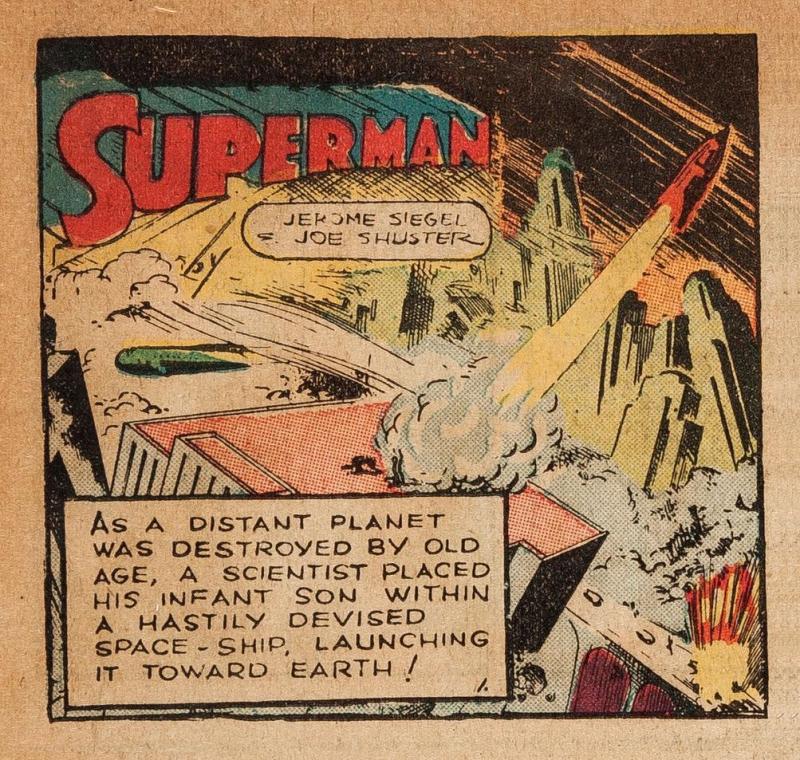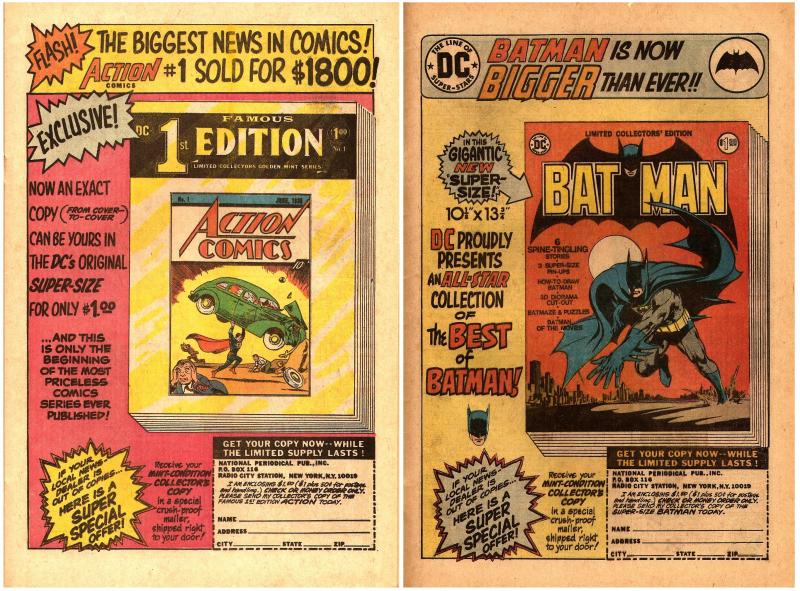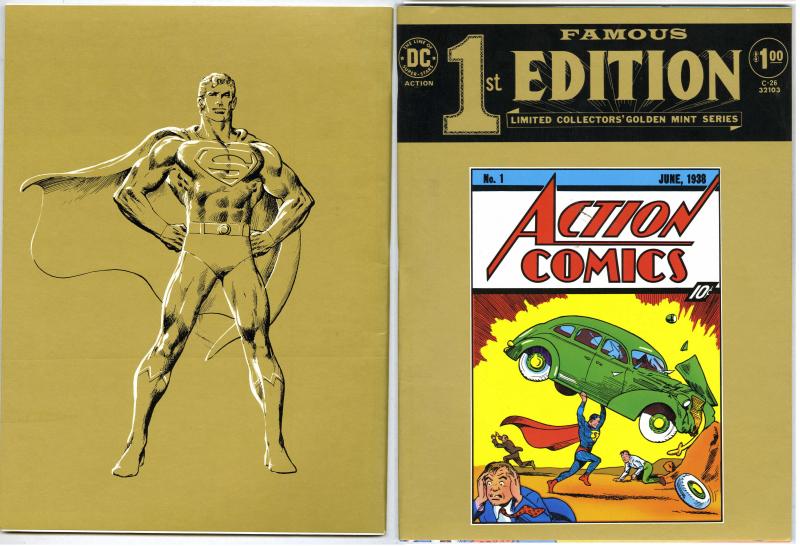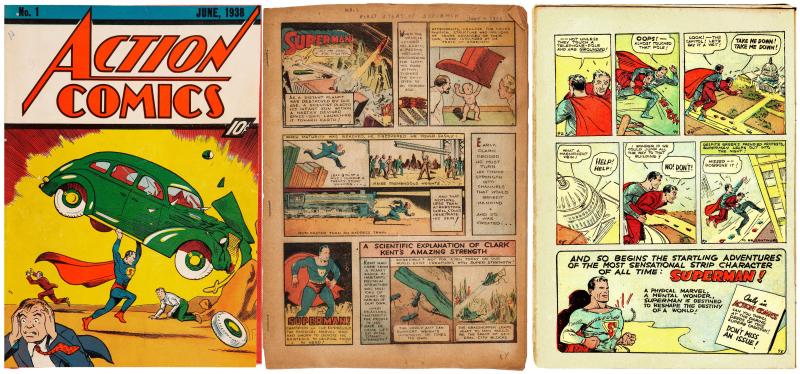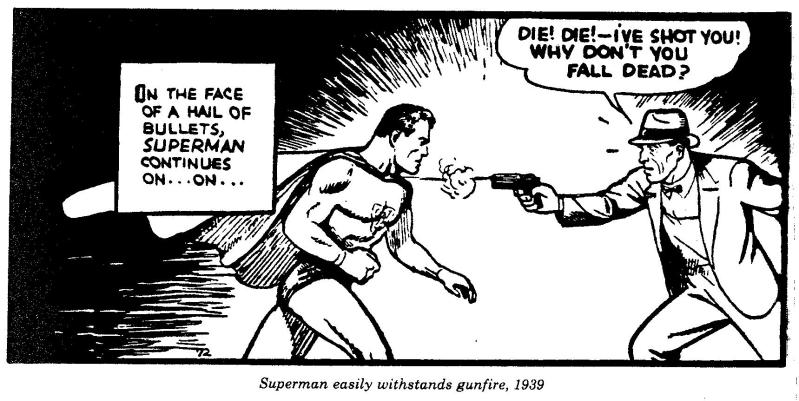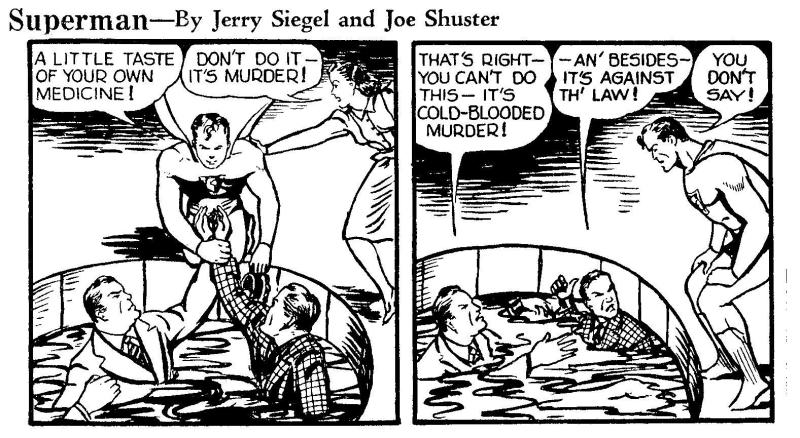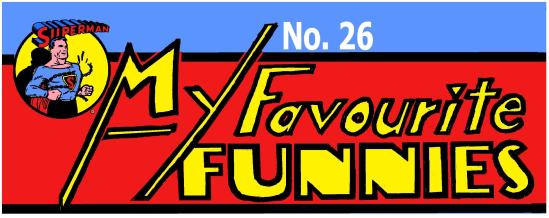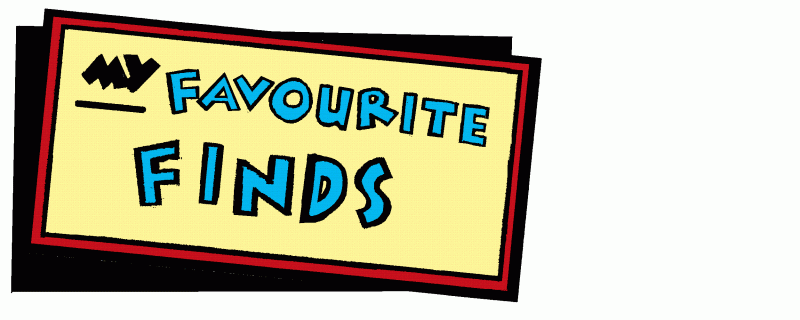by Jerry Siegel & Joe Shuster
First panel,Superman by Jerome Siegel & Joe Shuster, ACTION COMICS No. 1 (June ’38), on sale May 3rd, 1938.
famous first
At the beginning of 1974, National Periodical Publications released the first of its tabloid-sized FAMOUS 1ST EDITIONs. This reprinted in a facsimile format the entire contents of ACTION COMICS No. 1 (June ’38)–perhaps the most important funny book ever published.
House ads for the latest DC tabloid-size comics, in ACTION COMICS No. 433 (March ’74).
I ordered this using the clipped-out coupon provided in one of my DC comics. A few weeks later, the crush-proof mailer arrived with a big ka-thunk, as it dropped through the mail slot onto the floor and I raced down the stairs to get it. It came along with LIMITED COLLECTORS’ EDITION C-25 (featuring Batman)–the first FAMOUS 1ST EDITIONs were numbered with those tabloids, so this FAMOUS 1ST was numbered C-26.
FAMOUS 1ST EDITION C-26 (1974), available January 3rd, 1974–a card stock cover (with a swell Superman by Neal Adams on the back) over a replica slick cover, so what was beneath the card stock looked and felt exactly like the original artifact. A feature that later hucksters tried to exploit, by taking off the card stock cover and selling the book as an original copy of ACTION COMICS No. 1.
I’ll never get over that thrill as I opened this comic book and was transported to 1938, discovering the Man of Tomorrow for the first time! Where others of my generation and in my high school were tripping out on drugs–I never needed or wanted that sort of substance. I had funny books, the greatest mind altering substance one could ever find.
and as my first act
The entire anthology with all its different features is an education in comics history and I could go on at great length about all the wonders in that single issue, but let’s stick with the Man of Steel.
The debut Superman adventure is a bit of a mess, if I’m to be honest. From the books about comics history I had digested, by the time I first read C-26, I already knew that this was a paste-up job. Jerry Siegel and Joe Shuster had been trying to get their Superman published as a syndicated newspaper strip, so when they finally made the deal to have their hero published in ACTION COMICS, they had to cut up their strip and paste it together as funny book pages–leaving out a lot of key scenes. So, as a story, it doesn’t hang together so well, having several non sequiturs.
Superman by Jerome Siegel & Joe Shuster, ACTION COMICS No. 1 (June ’38), on sale May 3rd, 1938–cover art: Joe Shuster–red boots coloured in, coloured by Jack Adler–no red boots on the inside pages.
The first page jams in a montage of how Clark Kent came to be Superman. After that page, we’re thrown into the middle of a story–which will be fleshed out a year later when the comic book called SUPERMAN is published, with some of the missing action restored. As the adventure unfolds, our hero lurches from one spectacular event to another.
Along the way we see Clark commencing his job at THE DAILY STAR, working for an unnamed editor and initiating a friendship with a co-worker named Lois Lane. And, perhaps because yet another male reporter was jumping ahead of her on the paper, Lois is no fan of Clark Kent.
The final pages of this first jaunt take Superman away from his unnamed city (drawn by Joe Shuster to look like the Toronto of his youth), as Clark Kent investigates corruption in Washington, D.C. where the Champion of the Oppressed threatens a lobbyist.
second guesses
As I have said, the first adventure in ACTION COMICS No. 1 is more developed when it appears as a reprint a year later in the first issue of SUPERMAN.
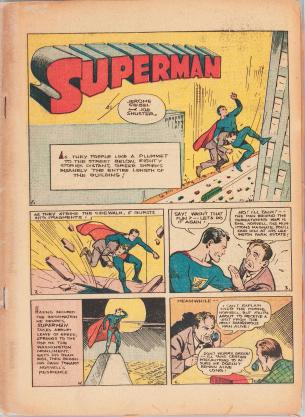 Even with these extra pages, the yarn represents a style of plotting common to Jerry Siegel’s early Superman adventures, including the newspaper strip. There is no one villain orchestrating events but rather several ne’er do wells and Superman/Clark goes from pillar to post in pursuing them.
Even with these extra pages, the yarn represents a style of plotting common to Jerry Siegel’s early Superman adventures, including the newspaper strip. There is no one villain orchestrating events but rather several ne’er do wells and Superman/Clark goes from pillar to post in pursuing them.
ACTION COMICS No. 2 (July ’38), on sale June 2nd, 1938.
The last part of the first adventure has Clark investigating Senator Barrows, then lobbyist Alex Greer. When the story picks up in ACTION COMICS No 2, the buck is passed to arms dealer Emil Norvell. That leads Norvell and Superman to the war in San Monte, where both become soldiers. Ultimately, the Action Ace forces a peace between the commanders of the two warring armies. And so it goes.
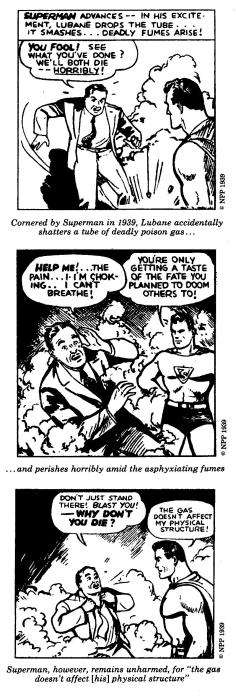 Likewise, a later plot in the dailies has Superman investigating a poison gas. This goes from Runyan–a supposedly good scientist though he needlessly kills Ambrose the monkey simply to demonstrate the potency of his gas–to bad guy Bartow to bad guy Lubane and back to Bartow. With a stop in Boravia for another senseless civil war, where Superman brokers a peace through force.
Likewise, a later plot in the dailies has Superman investigating a poison gas. This goes from Runyan–a supposedly good scientist though he needlessly kills Ambrose the monkey simply to demonstrate the potency of his gas–to bad guy Bartow to bad guy Lubane and back to Bartow. With a stop in Boravia for another senseless civil war, where Superman brokers a peace through force.
Lubane expires, Dailies 118 – 119, June 1st – 2nd, 1939. Used in Michael L. Fleisher’s THE GREAT SUPERMAN BOOK (1978)
It doesn’t help that Joe Shuster and the other artists in his studio draw all the bad guys to look alike or forget what one looks like and then draw him to look like another. The effect is that no one villain in particular shoulders responsibility for the misdeeds. Of course, this episodic plot development makes sense for dailies and Sundays–less so in the comics where Siegel and Shuster have 13 pages to play with.
I think it’s a holdover from Jerry Siegel’s early days writing for National’s NEW COMICS and MORE FUN. A feature would be only one page per issue (aping a Sunday page). Doctor Occult by Siegel and Shuster, for example, is only one page when the feature commences, later increasing to two pages and then four pages per issue. Given a yarn would be stretched over many issues, Siegel had learned to introduce some new menace in each instalment.
With ACTION COMICS No. 13, the arrival of the Ultra-Humanite shakes up that staggered style in Superman adventures, as now there is a mastermind behind all the criminal events.
However, in those Ultra thrillers, Siegel delays the revelation of the criminal genius and keeps the reader guessing. The greatest example of this is in ACTION COMICS No. 20 (January ’40) when the revelation will knock anyone’s socks off. Jerry must have enjoyed pulling the rug out right from under his readers with such a marvelous twist. [More on that next time.]
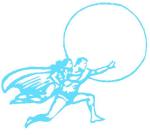
the man of two morals
Two assumptions about the early Superman have prevailed:
- Those primal adventures are about championing social justice–he is the Champion of the Oppressed, after all.
- The early Man of Steel imposes his own brand of rough justice–even to the extent of killing his foes.
Both assumptions have an element of truth. Yes, there are adventures where Superman has a social conscience. And yes, it’s true that Superman is rough on the bad guys and may even intend to kill a few evil-doers. But it is never so simple as that.

champion of the oppressed
I wonder what readers made of ACTION COMICS Nos. 2 – 4. The bulk of the story in the first issue seems to promise a few things–a colourful costumed character performing stunning feats in his city, a Clark and Lois drama at the DAILY STAR, the dual identity. But there’s little of that in the next three issues.
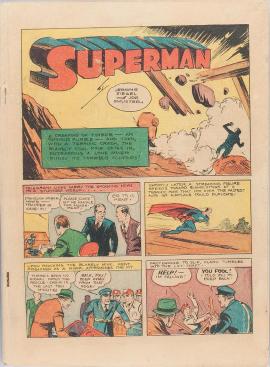 Superman isn’t even in his city (as yet without a name) and spends a lot of time out of costume–in fact, in ACTION COMICS No. 3, the costumed Superman only appears in one panel. Nor is Clark Kent present for most of these three adventures.
Superman isn’t even in his city (as yet without a name) and spends a lot of time out of costume–in fact, in ACTION COMICS No. 3, the costumed Superman only appears in one panel. Nor is Clark Kent present for most of these three adventures.
Superman appears in one panel on page 1–and that’s it–ACTION COMICS No. 3 (August ’38), on sale July 5th, 1938.
It’s like Siegel and Shuster have changed their whole focus for those issues. Each of these adventures is a morality tale. Superman has decided to give an individual a lesson in how to be a better person and improve himself. While interesting, this isn’t the Superman the readers were promised with the cover of that first ACTION issue.
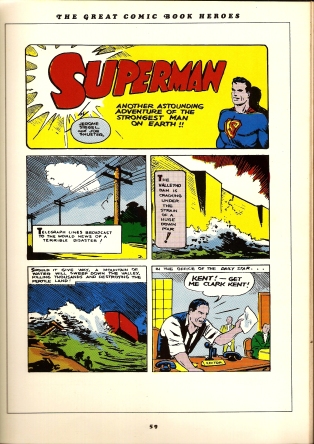 Clark gets back to the city and the newspaper, and the series gets back on track with ACTION No. 5. This is the first story that sets up many classic elements of a Superman adventure: the Lane and Kent newspaper rivalry, Superman saving masses of people from an impending natural disaster, Superman saving Lois Lane and Lois confessing her love for the Man of Steel.
Clark gets back to the city and the newspaper, and the series gets back on track with ACTION No. 5. This is the first story that sets up many classic elements of a Superman adventure: the Lane and Kent newspaper rivalry, Superman saving masses of people from an impending natural disaster, Superman saving Lois Lane and Lois confessing her love for the Man of Steel.
Jules Feiffer’s THE GREAT COMIC BOOK HEROES (1965) reprinted the Superman adventure originally published in ACTION COMICS No. 5 (October ’38) on sale September 6th, 1938.
The next few issues do a good job of showing off what Superman can do and with charm. The yarns that address social problems usually deal with corruption in the big city.
It doesn’t take a lot of analysis to see that the Man of Steel’s efforts to stamp out this corruption and make everyone do right are doomed to failure. He may threaten death and destruction, but he would have to appoint himself as absolute ruler and constantly monitor everyone in the city to ensure that his moral instruction is followed. Superman never does this, but rather leaves the city in the hands of law enforcement, the justice system and city managers.
His actions are wish fulfillment–what many of us wish we could do, when fustrated with the world as we find it. No surprise that the Man of Tomorrow held such appeal for children. Yet, as soon as Superman has made some moral correction, no doubt most of the people go right back to their immoral ways.
Daily 72, April 8th, 1939. Used in Michael L. Fleisher’s THE GREAT SUPERMAN BOOK (1978)
did the man of steel ever kill?
While the Action Ace sometimes carries through on his threats so far as property destruction goes, it’s never shown on panel that he actually kills someone. Those he might have killed are, conveniently, not pictured on panel as having died. And when it seems like Superman has in fact executed a criminal, such as Ultra, that villain turns up alive later.
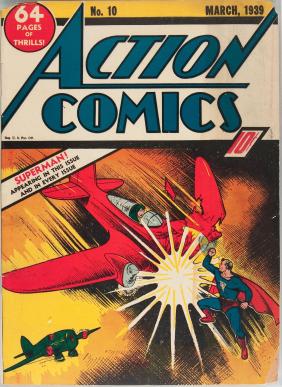 Whether the early Superman killed or not is left up to the reader to decide. For those fans who wish to believe that the Champion of the Oppressed has killed, there’s enough circumstantial evidence to suggest this was probably the case. But for others, such as myself, who want to excuse the Man of Steel from all charges, the circumstantial evidence does not prove the case for murder beyond the shadow of a doubt.
Whether the early Superman killed or not is left up to the reader to decide. For those fans who wish to believe that the Champion of the Oppressed has killed, there’s enough circumstantial evidence to suggest this was probably the case. But for others, such as myself, who want to excuse the Man of Steel from all charges, the circumstantial evidence does not prove the case for murder beyond the shadow of a doubt.
ACTION COMICS No. 10 (March ’39), on sale February 7th, 1939.
For Jerome Siegel, I suspect he started out not worrying about this. He likely didn’t think about whether some henchmen died or not in a given adventure, which may explain why he never follows through on the consequences of Superman’s violence.
But as the stories become more sophisticated, Siegel seems to deliberately avoid showing Superman killing anyone. Most deaths occur by misadventure, usually as a result of the wrong-doer’s own actions.
Dailies 280 and 281, December 7th – 8th, 1939. Superman threatens to kill a pair of thugs–which might be an empty threat for the purpose of extracting a confession–yet Lois Lane demands that Superman should not murder them in cold blood. Thus making explicit a prohibition on killing for the Man of Tomorrow.
the first superman song
ACTION COMICS No. 6 (November ’38) featured a wonderful Superman tale by Siegel and Shuster, in which they display their great sense of humour and sardonic wit. The yarn concerns a grifter who is trying to monopolize on the Superman brand–and there’s plenty of Superman product placement throughout the story.
There’s even a Superman song, sung by everybody’s favourite night club chanteuse–
YOU’RE A SUPERMAN
Swing it boys—
You’re a Superman
You can make my heart leap
Ten thousand feet
You’re a Superman
But I’m the one girl who kin
Get under your skin
When you crush me in your arms,
I must reveal,
I’m only flesh and blood and not resistless steel
You’re a Superman
Your ardor’s stronger than
A human man’s
You’re a Superman
And when you sprng to me
I am in ecstasy
Some day you’re gonna leap to the altar at my feet
Then the whole world will know
‘Cause I’ll tell all I know,
That I want ‘em to know.
That you’re my Superman
–words and music by Jerome Siegel and Joseph Shuster, arrangement by Paul Lauretta.
THE MAN OF STEEL’S EARLY RUN
continues in the next issue . . .
And for a full run down of the early Superman adventures (1938 – 1939) don’t miss My Checklist:
√ 20 Original Months of Superman
____________________________
Superman at the New York World’s Fair
Editor of ACTION COMICS, Vin Sullivan lined up a deal with the New York World’s Fair to package a special comic for the fair. He took the deal to his bosses at National/Detective Comics, Inc.–who were now Donenfeld and Liebowitz. As a result a big 96 page funny book featuring many of DC’s stars was available on April 30th, 1939, when the fair opened for its first season.
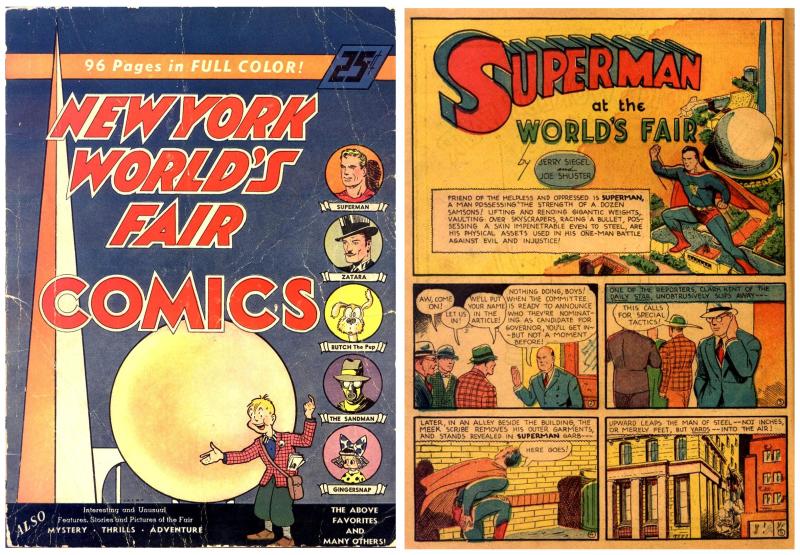
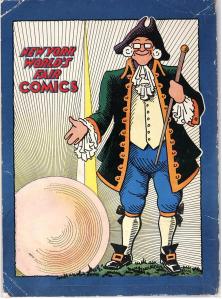 The big comic book was a hit and made a lot of money for the DC publishers–not so much for Vin, who left the company soon thereafter fed up with the ethical fugivity from the new owners.
The big comic book was a hit and made a lot of money for the DC publishers–not so much for Vin, who left the company soon thereafter fed up with the ethical fugivity from the new owners.
See the Extra page: Begin the Begin, Vin Sullivan
See this blog for a good run down of the contents in the 1939 issue: The World’s Finest Blog
Given the success of the first book, Donenfeld was ready to put out a second collection–now also starring Batman and Robin–for the second season of the New York World’s Fair in 1940. This comics was available as of May 11th, 1940 (Whitney Ellsworth, editor).
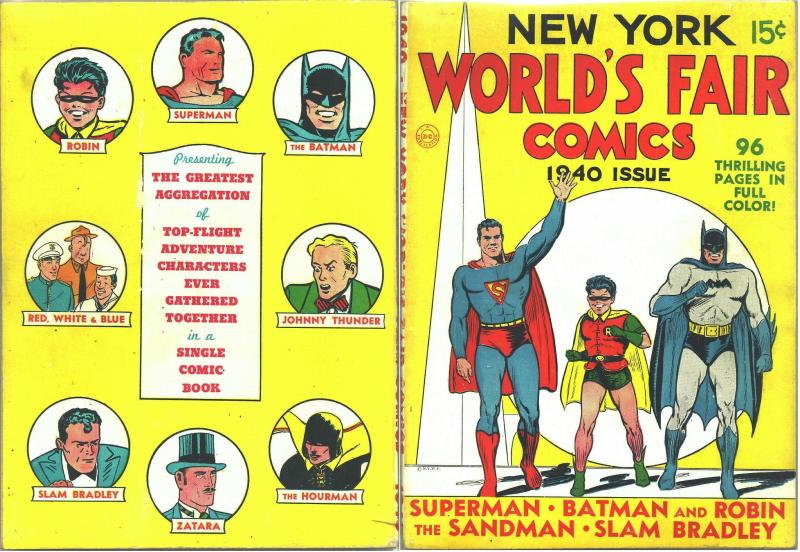
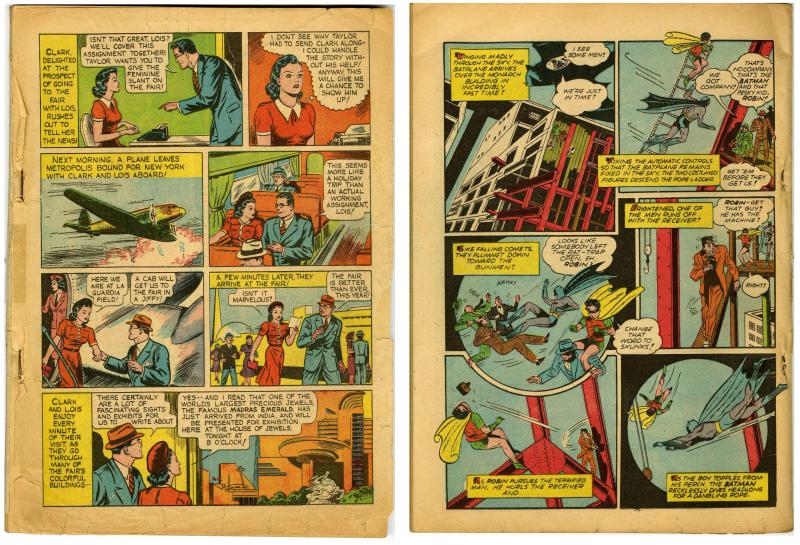

Superman at the World’s Fair by Allan Asherman, AMAZING WORLD OF DC COMICS No. 7 (July-August ’75), inside front cover.
As a special promotion, on July 3rd of that year, the fair held Superman Day, with athletic events and a public appearance by Superman himself. Some have identified this Superman as Ray Littleton; however, this is a misidentification and the true identity of the Superman is unknown. This actor is said to be the first to play Superman, but, of course, Bud Collyer had already been playing Superman on radio since THE ADVENTURES OF SUPERMAN had gone to air on February 12th, 1940.
Amazingly, there’s a colour home movie that captures some of Superman’s activities at the fair on Superman Day (July 3rd, 1940):
____________________________
Research information gleaned from Mike’s Amazing World of Comics, the Grand Comics Database, Who’s Whose in the DC Universe, THE GREAT SUPERMAN BOOK and other sources.
All characters, logos, and images are owned and © 2015 by current copyright holders. They are used here for educational and review purposes.


